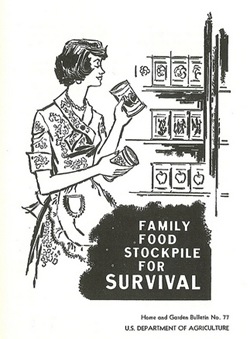9 Step Plan to Recession Proof Your Pantry and Food

Update, April 29, 2019: This article was originally posted in 2009 (yes, 10 long years ago) during the great recession in the United States. We went through every avenue, no matter how small, to teach families how save money during those tough economic times. Although the recession is now over, we find that more and more people are still looking for this kind of money saving help on how to live a more frugal life and do more with less.
In fact, a lot of people think another global recession may be coming in the near future. Whether it is or not, it’s better to be prepared with skills to provide for your family.
My family has personally been through more than one round of downsizing and layoffs over the last decade. Although that can be a scary situation, there are smart proactive ways to prepare for the worst-case scenarios, just in case. I hope this recession-proofing series is helpful to you, and that it can help your family reach your financial goals!
-Danelle
Recession Proof Your Food and Pantry
If you haven’t started yet, it’s time to recession proof your family. First, we’re learning how to recession proof your pantry and food. Is there the possibility of a layoff coming soon to your family? Maybe you got uncertain news like my husband and I did, that your employer may be downsizing, and that a few employees will have to be laid off. So what would we do if my husband lost his job?
You can quickly and painlessly recession proof your family now with our easy step by step instructions. Even if the worst-case scenario never comes true, you’ll still have extra money in the bank and the knowledge that you can have a great life on less. You’re going to get good at frugal grocery shopping, planning ahead, and being creative. Don’t worry- we’ll teach you how!
Steps to Take Right Now to Get Your Pantry Ready
Step 1: Read this first –> How to Use up Food in a Pantry Stockpile. Before you start your new stockpile, you’ll want to use up what you’ve got in your pantry so that you’re not mixing old and about-to-expire foods with new foods.
Step 2: Click this link to learn about easy ways to save money on groceries. We’ve written before about the best ways to save on groceries. Make sure you learn those basic tips first to get you on your way towards frugal grocery shopping.
Step 3: Inventory your pantry. Get step by step instructions for how to inventory a pantry. The pantry is going to be a lifeline when your income is reduced or gone, and you need it to be functional and ready. You may have to live off of your pantry for months.
Step 4: Stock up your pantry. Now that you know what you have, you also know what you need. Be on the lookout for coupons and sales for those foods and ingredients, and combine them.
Buy cheap and free food to fill your pantry. There are many blogs about frugal grocery shopping to share matchups and sales and coupons. To save you the time of bouncing from site to site, we recommend Money Saving Mom, the most complete frugal grocery shopping site out there. Crystal Paine lists the best sales at different grocery stores, along with printable coupons you can use on the sale items to buy them for free or very cheap.
What to buy for stocking up the pantry:
-
- Go heavy on beans, grains, dry pasta, dry and canned foods.
- Buy flour, sugar, and other baking staples.
- If you find good deals on perishables that can be frozen or canned for later (like fresh veggies or bread), buy as much as you have room to store.
Step 5: Consider buying a freezer.
A second freezer is your money-saving best friend. And speaking of freezing food that you find for great deals, I’ll share a strategy that’s worked well for my family for years.
We always keep a second freezer in the garage or laundry room (wherever we have space!). In the extra freezer I can not only stockpile frozen breastmilk for the babies, but freezer meals I’ve made ahead in bulk, meat bought on clearance or huge coupon reduction, frozen produce that I don’t want to go bad, homemade bread, and sweet cheap deals I found at the store.
I prefer a stand-up freezer over a chest freezer since it’s easier to see all the food you have available and much easier to access it. Of course, it’s personal preference which type of freezer you like best and what you have room for in your house.
Also, you may live in a place where a lot of people hunt wild game for meat. We are from Alaska and many people hunt each year for moose, caribou, bear, even ptarmigan and grouse. Here in Colorado, where we live now, people hunt deer and wild turkey (although much fewer people hunt here than in Alaska). Fishing is an option almost everywhere that can fill up your meat stockpile quickly with healthy proteins that are quite expensive to buy at the grocery store.
In fact, many people we know in Alaska keep a 2nd or 3rd freezer that is JUST to hold their hunted meat and fish!
Step 6: Start cutting your ground meat now. How to stretch ground meat with frugal fillers. If you normally cook ground beef or ground turkey pure, just the way it comes out of the package, it’s time to learn how to cut ground meat with frugal fillers. You’ll need to know how to stretch the small amount of meat you buy to make more than one meal at a time.
Step 7: Gather bread recipes and practice making your own bread. It may take several attempts before you settle on a recipe you really like. Of course, if you find day-old bakery items on clearance, such as bread, bagels, biscuits, etc., buy them and pop them into the freezer for later. However, you can almost always make your own bread for less than clearance prices.
Step 8: Plant seeds now. Growing food does not have to be an expensive project. If you don’t have a garden or greenhouse, you can use odd containers you have around the house to start your plants indoors, then move them to larger pots on your porch or patio. Perfect starter containers include plastic butter tubs, plastic yogurt cups, sour cream containers, coffee containers, and plastic trays that taco shells come in.
There are many more perfect seed-starters around your house – just don’t throw away any food packages that might have another use. Buy your seeds in packets. Packaged seeds are very inexpensive and will save you the expense of buying plants someone else has gone to the trouble to start.
Step 9: Share frugal food with others. Find a like-minded frugal family (neighbors, friends from church, etc.) that you can exchange cooking tips and food prep with, and have potlucks, cookouts, and weekend meals to share. Living History Farm writes, “During the Depression, this self-sufficiency carried over into their social life. One-dish suppers and church potlucks were important ways to have fun and share food.”
Have you read the previous pieces in the Recession Proof Your Family series?
Recession-Proofing: It’s Not About How Much You Make
How One SAHM Recession-Proofed Her Family
Recession Proof Your Pantry and Food
5 Surefire Ways to Recession Proof Your Job
How have you recession-proofed your family? What recession-proofing tips do you have to share? Feel free to let us know in the comments. Family food image by Seattle Municipal Archives.




19 Comments
Farrah from Wife and Mom of 3
Never new about filling filling ground beef…I’m going to have to try that one out.
calina
Great ideas! Everyone should be doing these things!
Beverly
I think this is very important since so many people are losing there jobs now and many really would not know what they need to do.
Pingback:
Brooke
filling ground meat its definitely something i need to read up on. even though i typically find it for $1.50 or less, it would still help to stretch it. after all its just going into spaghetti, chili, or something similar.
Liz @ Hoosier Homemade
Awesome article! Thanks for all your hard work!
Brenda
Thanks for sharing this. Like the above commentor, I was aware of the meat fillers. Right now, I’ve just been cutting down on the amount of meat used in a recipe.
Brandi J.
This is something that my hubby and I have been working on! You mentioned some things we have not thought about! Thank you!
Houstonmom
I found your site today on Frugal Friday. I love how you’re “recession proofing.” We hear so much doom and gloom, but not enough on how to overcome. This is inspiring!
tami lewis
i really enjoyed this entry! thanks danelle!
Adlyn
Great ideas! Everyone should be doing these things! i really enjoyed this entry!
Pingback:
Pingback: